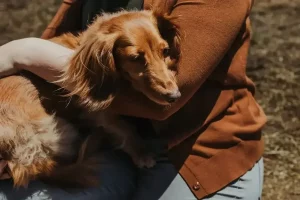Facing the decision of euthanasia for a beloved dog is an emotionally challenging experience, and knowing how to provide comfort in their final moments can be vital for both the pet and the owner. Establishing a serene environment and employing gentle physical touch can greatly ease anxiety. Additionally, the power of soft-spoken words and cherished memories can create a profound sense of connection. As you navigate this heart-wrenching process, it is essential to reflect on various strategies for how to comfort your dog before euthanasia to ensure your dog feels loved and supported during their final moments. What specific approaches can enhance this intimate farewell?
Key Takeaways
- Create a calm environment by choosing a quiet, familiar space with dim lighting and comforting items.
- Offer gentle physical touch and affection to reassure your dog and strengthen your bond.
- Speak softly and maintain eye contact to convey love and create a peaceful atmosphere.
- Include familiar scents and favorite toys to evoke positive memories and ease anxiety.
- Share a cherished memory or moment to provide comfort and connection during their final moments.
Understanding Euthanasia for Dogs
Understanding euthanasia for dogs can be an emotionally challenging process for pet owners. It often comes at a time when the bond between you and your beloved pet is at its peak, filled with cherished memories. This decision is never taken lightly, and it is crucial to approach it with compassion and understanding.
Euthanasia is a humane option when a dog is suffering from terminal illness or severe pain that cannot be alleviated. This procedure aims to prevent further suffering, allowing your pet to pass peacefully. While the decision may feel overwhelming, it is often an act of love and kindness, prioritizing your dog’s comfort over your own heartache.
During this difficult time, seeking support from veterinarians, pet loss counselors, or support groups can provide a sense of community and belonging. They can help guide you through the emotional landscape surrounding this choice, offering insights that can ease your burden. Remember, you are not alone in this journey; many pet owners have navigated similar paths and understand the depth of your feelings. It’s natural to grieve, and honoring your pet’s life is an important part of the healing process.

Signs Your Dog Needs Comfort
How can you recognize when your dog needs comfort during this difficult time? Understanding your dog’s subtle cues is essential for providing the support they need. Look for signs of distress, such as excessive panting, pacing, or restlessness. These behaviors may indicate anxiety or discomfort, prompting your dog to seek solace.
Additionally, changes in appetite or interest in activities they once enjoyed can signify emotional or physical pain. If your dog becomes unusually withdrawn or seeks to isolate themselves, this may be a clear indication that they require comfort and reassurance.
Pay attention to their body language; a lowered head, tucked tail, or lack of eye contact can reflect fear or uncertainty. Conversely, if they lean into you or seek your presence, it signifies a desire for connection during this challenging time.
Recognizing these signs is not just about observing behavior; it’s also about understanding your dog’s emotional state. By being attuned to their needs, you can provide the love and comfort they need as they navigate their final moments. This connection can help both you and your beloved pet find peace in this heartbreaking journey.
Creating a Calm Environment
Recognizing the signs that your dog needs comfort is the first step in providing the support they require. Creating a calm environment is essential in allowing your beloved pet to feel safe and relaxed during their final moments. Start by choosing a quiet space, free from loud noises and distractions. This familiarity can provide reassurance, making the setting less intimidating.
Dim the lights to create a soothing atmosphere, as harsh lighting can be unsettling. If your dog enjoys specific items, such as their favorite blanket or toys, include these in the space to promote a sense of belonging. Surrounding them with familiar scents can also evoke positive memories, helping to ease anxiety.
Consider playing soft music or gentle sounds that your dog enjoys, as this can further enhance the tranquility of the environment. Keep in mind that your demeanor plays a significant role; speaking softly and calmly can help convey a sense of safety. By thoughtfully crafting a peaceful space, you are not only helping your dog feel more comfortable but also creating an opportunity for a loving farewell. This supportive environment can make a significant difference in how your pet experiences this difficult change.
Physical Touch and Affection
In moments of profound emotional weight, the power of physical touch and affection cannot be underestimated. As you prepare to comfort your dog before euthanasia, providing gentle, loving contact can offer immense reassurance. Your presence, expressed through soft strokes and comforting embraces, can help soothe anxiety and create a sense of safety during this difficult time.
Physical touch serves as a crucial connection between you and your pet, reinforcing the bond that has been nurtured throughout their life. As you caress their fur or hold their paw, you communicate love and understanding, allowing your dog to feel your warmth and support. Consider speaking softly as you engage in this affectionate interaction; your voice can be a calming presence that further alleviates their stress.
Additionally, be attuned to your dog’s responses. Some may seek more touch, while others might prefer gentle proximity. It is essential to respect their comfort level and adjust accordingly. Ultimately, your physical presence can create a peaceful atmosphere, ensuring that your dog feels loved and cherished in their final moments. This connection will provide solace for both you and your beloved companion.
Saying Goodbye With Love
As the moment to say goodbye approaches, it is important to embrace the opportunity to express your love and gratitude for the time shared with your dog. This final farewell can be a profound experience, and how you choose to say goodbye can offer comfort to both you and your beloved pet.
Here are three meaningful ways to say goodbye with love:
- Share a Favorite Memory: Recall a cherished moment you shared together. Speak softly about that day, allowing your voice to be a soothing balm for your pet’s spirit.
- Create a Peaceful Environment: Surround your dog with familiar items—blankets, toys, or photographs. This can help ease their anxiety and provide a sense of comfort during this difficult time.
- Be Present: Hold your dog gently and maintain eye contact, using your presence to convey your unwavering love. Your calm demeanor can help reassure them that they are not alone in their final moments.
In these tender moments, remember that your love will remain a part of their journey, and the bond you shared is everlasting.
Frequently Asked Questions
What Can I Bring to the Euthanasia Appointment?
When attending a euthanasia appointment, consider bringing a favorite blanket or toy, your dog’s medical records, and any comforting items that create a familiar environment. These can help ease the shift for both you and your pet.
How Do I Choose the Right Time for Euthanasia?
Choosing the right time for euthanasia involves evaluating your dog’s quality of life and comfort. Consult your veterinarian, considering signs of pain or distress, and trust your instincts—prioritize your pet’s well-being during this difficult decision.
Can I Be With My Dog During the Procedure?
Yes, you can be with your dog during the procedure. Your presence can provide comfort and reassurance, helping to ease their anxiety. This shared moment can strengthen your bond and guarantee a peaceful change for your beloved pet.
What Happens to My Dog’s Body Afterward?
After euthanasia, your dog’s body is typically handled respectfully. Many veterinarians offer cremation or burial services, ensuring a compassionate farewell. Understand that your pet’s spirit remains cherished in your memories, fostering a sense of belonging.
How Can I Cope With My Grief After Euthanasia?
Coping with grief after euthanasia is a deeply personal journey. Allow yourself to feel emotions, seek support from friends or pet loss groups, and consider memorializing your pet to honor their memory and facilitate healing.
Conclusion
In the final moments of a beloved dog’s life, providing comfort is paramount. By creating a soothing environment and engaging in gentle physical touch, the change can be made more peaceful. Maintaining a calm demeanor and sharing fond memories fosters a sense of security. Ultimately, the love and care offered during this difficult time can help ease the experience for both the dog and the caregiver, ensuring that the final moments are filled with compassion and warmth.
Also Read: Enhancing Emotional Wellness in Later Life
